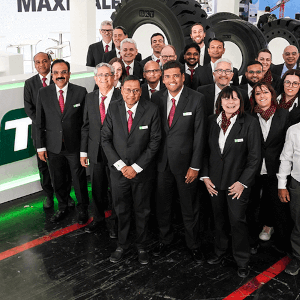The agricultural industry has been evolving over the last several centuries, with new seeds of innovation constantly being sown. Over the years, we’ve witnessed man and machinery joining forces, and this is set to continue, as our priorities shift and the world’s landscape changes. So, what are you waiting for? Let's take a look at the top agricultural trends for 2023!
The agricultural industry has been evolving over the last several centuries, with new seeds of innovation constantly being sown. Over the years, we’ve witnessed man and machinery joining forces, and this is set to continue, as our priorities shift and the world’s landscape changes.
Darker days and crisper leaves are the tell-tale signs that this year is already coming to an end. While 2022 has seemingly flown by, we need to prepare for the year ahead; it is imperative that you keep ahead of the curve in the farming world, and BKT is here to help! So, whenever you’re ready, we’ll whizz through our predictions for agriculture trends in 2023. These trends fall under two topical umbrellas: sustainable initiatives and developments in agritech. But firstly, let’s focus on the most important mission of our lives: saving the planet we call home.
Sustainable Initiatives
As we embark upon a new year, our sustainable goals will only intensify. Year upon year, the global mission to reach Net-Zero increases in urgency, and this is reflected in sustainable initiatives across all industries. Not only do companies shoulder a collective responsibility to save our planet, but consumers are beginning to align exclusively with brands who promote ethical, environmentally friendly practices. Therefore, it is in everyone’s best interest to think and act greener – and the agricultural industry is no exception.
It is no secret that the global population is ever-growing, and this naturally leads to the necessity for more food production – and more harmful greenhouse gasses expelled into the atmosphere. That is, unless we continue championing more sustainable methods of food production – which 2023 is set to continue! The journey from farm to fork involves numerous stages, and with initiatives such as bioplastics being introduced to make food packaging greener, it is our responsibility to ensure that the processes prior to this are equally sustainable.
Regenerative Agriculture
With these sustainable goals in mind, we predict that regenerative agriculture will take center stage next year. Regenerative agriculture focuses on maintaining soil health, and is renowned for “improving the resources it uses, rather than destroying or depleting them." For example, farmers are increasingly taking the ‘au naturel’ approach with minimal use of chemical fertilizers, ‘green’ water management and the active rotation of crops. Also, they are encouraged to plant a diverse range of produce, in order to feed different nutrients into the soil.
But why is soil health so important – and even more so in 2023? Well, the Clean Label trend portrays consumers’ increasing need for transparency; particularly within the plant-based industry, products are under intense scrutiny for the use of processed ingredients. Therefore, it is prudent that farmers hop aboard the trend of regenerative farming, for the sake of both business and sustainability.
Rewilding
Rewilding is a key example of regenerative agriculture, which we felt deserved a shout out of its own, as we believe that it is in our best interest to prioritize rewilding in 2023. The verb ‘to rewild’ means “restoring (an area of land) to its natural uncultivated state” through different levels of human intervention. The ultimate aim is to reintroduce plants and species into the ecosystem.
Why is this beneficial for the environment? Well, it goes without saying that the world is a brighter, greener place in its natural state, as Mother Nature intended it. Healthy, thriving ecosystems naturally provide sought-after clean air, nutritious soils and unpolluted water – not to mention helping to mitigate extreme weather events such as flash floods.
Vertical Farming
Controlled Environment Agriculture, otherwise known as vertical farming, is another up-and-coming trend in the agricultural industry. In 2023, the predicted surge in vertical farming will be an efficient response to the increased demand for food production, while also paving the path to a more sustainable future. Not only can higher quantities of crops be harvested in a smaller space, but the urban location of most vertical farms simply means that the need for transportation of goods is significantly reduced. Water usage is also more efficient; vertical farmers’ smart controlled systems ensure that only necessary amounts of water are used, and any residue liquid is stored for reuse.
What’s more, in addition to actively fighting against it, we are also collectively facing the current consequences of the climate crisis. 2023 will unfortunately see increases in extreme and unpredictable weather conditions, yet vertical farming provides a controlled, optimized environment – meaning that crops are protected from adverse weather, and yield goals can still be met.
Agritech
We are very much living in a technological world. As we journey through Industry 4.0, technology reigns supreme – with technological advancements shaping countless industries worldwide. We have certainly come far since the invention of the first tractor! Long gone are the days where crops were harvested by hand; on the contrary, machinery dominates the daily processes on the farm – and without them, we would simply be unable to compete with the ever-increasing global food demand. In fact, new technologies are being developed by the day, in order for us to keep up!
What’s more, the Fourth Industrial Revolution also aims to counteract the environmental damage caused by the many industrial ‘booms’ before. Many of the agritech trends of 2023 will be designed to help protect the environment – so, without further ado, let’s take a look!
Artificial Intelligence
Everybody’s talking about AI. As we battle to keep up with increased demand for food production, Artificial Intelligence provides a much-needed helping hand. These hyper-intelligent machines provide a highly efficient workforce that assists with overall workload on the farm, including tasks such as: harvesting crops, monitoring soil health and fighting pests and crop disease. As the global population is predicted to skyrocket to 9 billion by 2050, we certainly need all the help we can get!
There are many examples of agricultural AI which are set to trend in 2023. However, with our own sustainable ethos, we are particularly excited by the development of Naio technologies. These robots help with the harvesting process, and are specifically designed “to help grow healthier, more abundant and environmentally friendly crops.”
Smart Farming & IoT
Smart farming is all the rage – as is anything ‘smart’ nowadays! In 2023, we predict that the Internet of Things will play an even bigger part in agricultural systems, allowing farmers to use smart devices to monitor all operations on their farm. This allows them to maintain a hands-on approach, even when daily processes are predominantly carried out by technology. The data collected by IoT devices allows farmers to make well-informed decisions on a day-to-day basis; big data, for example, gives farmers insight into rainfall patterns and water cycles, which therefore optimizes crop growth.
To learn more about IoT in agriculture, check out our article here.
Drones
Drones are being increasingly used in the agricultural industry – and the development of solar drones is a promising notion for 2023! Drones are ideal for any task that involves precision beyond the human eye, boasting expertise in daily chores on the farm, such as: planting, crop spraying and crop monitoring, to name but a few. Drones can dramatically increase crop yield, which is all the more important as the global population increases.
Hydroponics
Hydroponics is a new up-and-coming technology in the agricultural industry. This allows plants to grow through water instead of soil - through nutrient-rich water solvents, to be precise. This is a key example of Algae Farming. If you’ve never heard of Algae Farming before, don’t fret - check out this article to learn more. This cheaper, efficient alternative to traditional farming is certainly something to look out for in 2023!
We hope you’ve enjoyed our lowdown of the latest agricultural trends, and hope our trusty guide helps you to stay ahead of the curve! To discover more about the world of farming, visit our website - we hope to see you there!






.jpg)